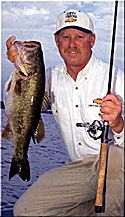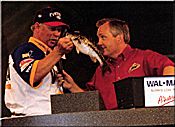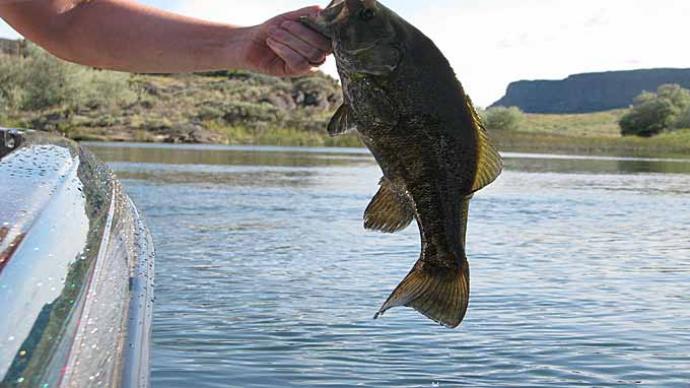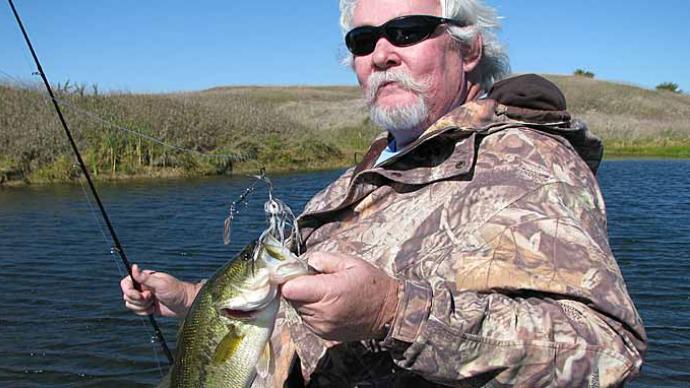
Savvy tournament anglers frequently rely on crankbaits to help them eliminate nonproductive water and locate areas that hold concentrations of bass. Since competitive fishing makes you race the clock even on practice days, it only makes sense to employ a lure that quickly combs subsurface structure and cover. No other lure keeps pace with a crankbait.
There are periods throughout the year when crankbaits elevate their status from fish finders to become the primary lures in your arsenal. Autumn is undoubtedly one of those times.
As the water cools, bass move up from deep water and eagerly pounce on crankbaits that resemble the baitfish on which they feed. Accomplished professional bass anglers are well aware of these facts and take full advantage of them come fall.
"I've been cranking bass in the fall for about 20 years," says Arkansan George Cochran, a highly respected pro with a stellar angling career. "The action generally picks up somewhere between the first of September and the first of October and can continue right into December in some parts of the country."
While crankbaits may produce bass anywhere on a given body of water, Cochran gives feeder creeks his highest priority when he fishes impoundments. At this time of year, his preference is major creeks and tributaries that actively flow into the lake, as opposed to stagnant pockets and coves. Incoming water, he has found, attracts baitfish in the fall, and the bait brings the bass along in tow.
"Once I find a creek that has baitfish in it," Cochran says, "I'm confident bass are nearby. Sometimes bass migrate as far up a creek as you can get your boat. But, usually, the bigger fish hold in channel bends where they ambush shad coming and going in the creek. I bypass straight stretches and concentrate on the bends."
Inside bends generally yield more bass to Cochran's crankbaits than outside bends that feature steep banks. Any type of cover on an inside bend is a bass magnet, including chunk rock, stumps and windfalls.
In most instances, Cochran casts beyond whatever cover he finds up a creek. Then he winds the crankbait down and runs it into the object. Bumping cover with a crankbait, one of the most basic of all presentations, continues to produce reaction strikes for Cochran.
"If the sun is shining," Cochran says, "bass are more predictable because they tend to get close to cover. You have to be real precise with your casting, and you may have to bump the cover on two or three consecutive casts before you get the hit. On cloudy days, bass often move away from cover and cruise. That's when you have to keep trying different angles and depths until you figure them out."
If his crankbaits fail to draw strikes from shallow cover, Cochran backs his boat out to deeper water in the middle of the creek. He has learned that bass sometimes suspend in the creek just out from the cover. Backing away allows his crankbaits to run past these more elusive fish.
"It's real important to match your crankbaits to the bait you see in the creeks," he says. "If the baitfish are 2 inches long, that's how big your crankbait should be."
In the fall, Cochran does especially well with white crankbaits. He varies the color of the lure's back to match the hue reflected from the bait, typically black, green, blue or khaki. In deeply stained or muddy water, a chartreuse back gets the nod.
Cochran's primary creek crankbaits dive no deeper than about 8 feet. He has won several major bass tournaments fishing a large-bodied crankbait that runs 2 to 5 feet. He designed such a lure for Strike King called the Series 4S. He sometimes makes this lure run less than I foot deep by holding his 7-foot fiberglass cranking rod high during the retrieve and using 15-pound-test line.
Cranking major creeks pays off for Georgia's Tom Mann Jr., another widely respected FLW Tour pro. Early in the fall, Mann begins searching for bass down near the mouths of creek arms and works his way up until he finds the fish. He generally doesn't have to go up into the confines of a creek to catch bass until sometime in November. Prior to that time, Mann targets flats, bars and points in 4- to 6-feet of water.
"I always like to stay as near the creek channel as I can," Mann says, "but that's not possible when the channel lies far from either bank and in deep water. The ideal situation is where a meandering channel swings toward a shoreline and brushes against a bar, point or flat."
When Mann locates this perfect setup, he positions his boat over the channel and seines the adjacent shallow structure with a crankbait. If a point or bar sits back away from the creek channel, Mann abandons the channel and moves within casting range of the structure. Stumps, snags or some other cover on a structure increases the likelihood that it holds bass, but even bare structures regularly come through for Mann in the fall.

"At that time of year," he says, "cover isn't crucial. What you've got are bass following pods of baitfish in open water. The bait, not the cover, is what attracts the bass. Cover is beneficial, but I've caught plenty of bass from bare, shallow structures that didn't have any cover."
An especially important factor for Mann at this time of year is the wind. Schooling shad and other baitfish tend to collect on windward structures and bass move in to take advantage of the easy pickings.
"I always target the side of the creek the wind is blowing toward," Mann says. "The thing bass know how to do best is find food. They know instinctively where to go when the wind blows."
The Yo-Zuri Crank & Dive produces many bass for Mann in the fall. He opts for shad colors in clear to slightly stained water and chartreuse patterns in dingy water.
"In early fall," Mann says, "I fish a bait that gets down 6- to 8-feet deep. As it gets cooler, I switch to a wide-wobbling bait that doesn't run over 3 feet deep. The baitfish determine which size plug I throw."
Smaller crankbaits regularly do the trick on autumn bass for Florida fishing ace Bernie Schultz. He regularly casts Bomber crankbaits in 2A to 6A sizes, the Excalibur Fat Free Fingerling and the 1/4-ounce Super Spot. Firetiger is his number one color in diving crankbaits, but he prefers chrome with a black or blue back when casting a lipless rattler.

"If I'm fishing a reservoir," Schultz says, "I concentrate on 45 degree sloping banks close to deep water. These can be on the main lake or in the creek arms. On sunny, bluebird days, I look for off-colored water. If skies are low and cloudy, I won't hesitate to fish clear water down near the dam."
Schultz lets the baitfish tell him which type of bottom composition to key on. Baitfish usually show a preference. It could be a singular substance, such as clay, rock or gravel. Frequently, it is a mixture of elements, say rock and clay, or rock and wood. Whatever type of bank attracts schools of bait in one area of a lake generally does likewise elsewhere on the same body of water. For observant anglers like Schultz, this creates a reliable pattern.
"I basically just quarter the bank and cover water fast," Schultz says. "I keep moving until I find bass or come across an especially good target, maybe a stump or dock. It usually goes one of two ways. You'll either pick up a bass every so often, or you find them concentrated where there's baitfish. In the latter case, you've got to be really thorough and patient. Fish the same area over and over."
River systems also surrender bass to crankbaits in the fall. Gary Dees, one of the Buckeye State's most accomplished Red Man anglers, makes the most of this when fishing Ohio River tributaries.
"I catch a lot of bass on underwater cover out away from the bank," he says. "You can't see the cover, so it rarely gets fished. Running creek banks with crankbaits helps me find these spots. If my crankbait bumps a piece of cover but doesn't trigger a strike, I'll follow up with a small ring worm."
If Dees sees an abundance of shad relating to visible wood cover on shallow flats, he sticks with his crankbait rod. He often holds his rod high and moves the bait ahead with the rod tip, almost as if he were fishing a worm with a pull-pause action.
Whether the bass are relating to shallow visible cover or hidden subsurface objects, Dees seduces bass with the D Bait, a crankbait he designed himself. This small, flat-sided balsa lure comes with a foil finish and floats up slowly when stalled.
"The slow rise is one reason the D Bait catches so many bass," Dees says. "The lure hangs in a bass's face a little longer when you stop cranking, and that's when they nail it."
Content provided by Bass Fishing Magazine, the official publication of FLW Outdoors




